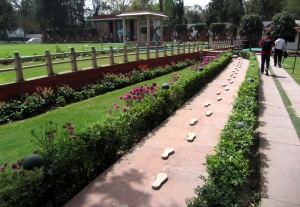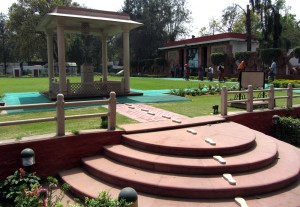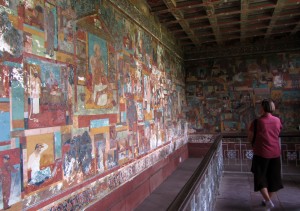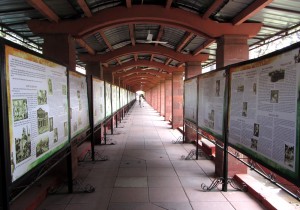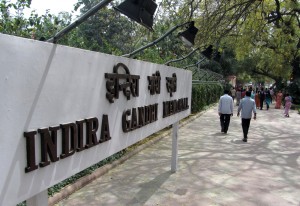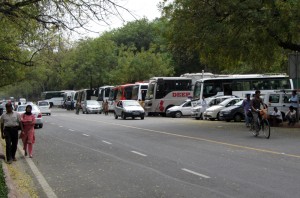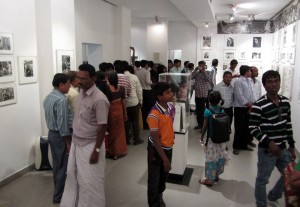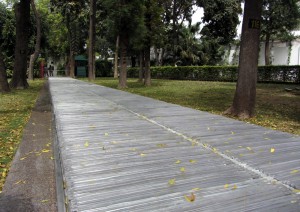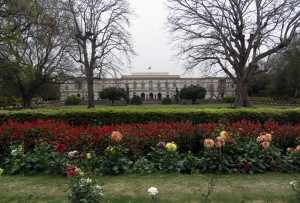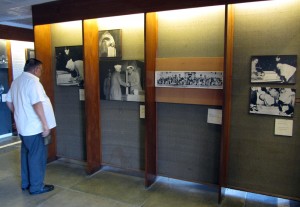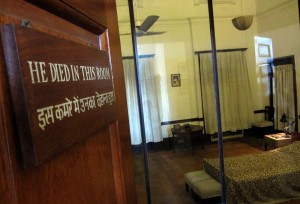Compared to Mumbai and Jaipur, Delhi was like a dreamland, with a lollipop sun shining down on streets paved with gold. Sure, the moment we stepped off the train an army of rickshaw drivers descended upon us and yes, we paid too much for the ride and no, the rickshaw driver didn’t know where our hotel was. But let’s not dwell upon that, shall we?
New Delhi is the capital of India, and my sightseeing agenda was appropriately political, with two Gandhis and a Nehru on the agenda. Although it was Karen’s turn to experience tummy trouble, even she couldn’t resist the siren call of a city with a clean, efficient metro system and (some) clean streets.
[youtube_sc url=”http://youtu.be/pbMREfZL1y0″]
Our first stop was Gandhi Smriti, Mahatma Gandhi’s last residence and also where he was assassinated in 1948. It is now a memorial.
The museum is a curious hybrid: the older section is painfully text-heavy, while the new section is a mishmash of multimedia experiences of varying quality.
The area where Gandhi was shot is tastefully preserved, with stone footprints tracing his last steps. There’s a colorful mural nearby (let’s play Spot The Historical Incident- hey, there he is defying the salt tax!), and a walkway with lots… more… text. Some of it English text, mind you, and I’m not complaining. I learned a lot.
But with so much to see, where was everyone? Gandhi Smriti was practically deserted.
Karen and I walked a few streets over toward the Indira Gandhi Memorial Museum, her last residence and also where she was assassinated in 1984 (are you seeing a pattern here?). Rounding the corner, we were surprised to see a long line of people, almost all Indians, snaking from the entrance around the block. Tour buses jockeyed for parking across the street.
We gamely got in line and shuffled into Indira’s house. The story of her rise to become India’s first female Prime Minister is told through photos and newspaper reprints, an interesting approach. Oddly, in the middle of the narrative, you see the sari she died in, and then it’s back to the narrative. After reading about her death, you see photos of her as a baby and read about her upbringing. At the risk of being hopelessly traditional, I humbly suggest that a chronological approach would be more useful to the uninformed.
And uninformed we were. Indira is not Gandhi’s daughter, she is Jawaharlal Nehru’s daughter, so why, we wondered, is she a Gandhi? We couldn’t glean the answer from the exhibits. Later research revealed that her husband, Feroze Gandhi, was unrelated to Mohandas.
The area of Indira’s assassination is tastefully presented. Here, the last path she walked shimmers like crystal. Crowds of Indians took advantage of the photo op.
No offense to I. Gandhi, but why was everyone here, while nary a tour bus graced M. Gandhi’s house? Someone later told us that the tour groups head there next. Memo to enterprising tour operators: go to M. Gandhi’s house first to spare your customers the long lines and yourself the parking hassle.
Last stop on our political tour: the Nehru Memorial Museum and Library. The museum dedicated to India’s first Prime Minister was the least polished of the day. Photos were literally falling off of dusty exhibit boards, and once again key details eluded the uninitiated.
In one room hung a sign: “HE DIED IN THIS ROOM.” When? Of what? How did the nation mourn? What were the political consequences? Google it.
We were hot and sweaty, Karen’s stomach still wasn’t right, it was time to head home on the metro. The shiny, efficient metro! Our Delhi dreamland!



